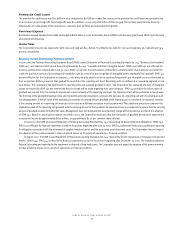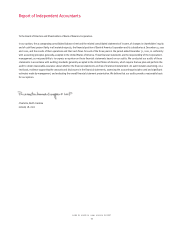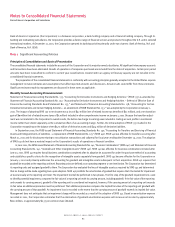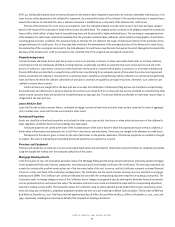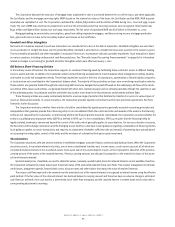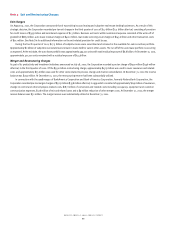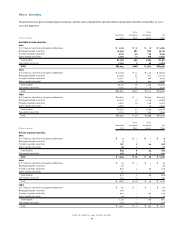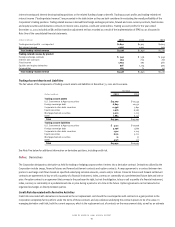Bank of America 2001 Annual Report Download - page 87
Download and view the complete annual report
Please find page 87 of the 2001 Bank of America annual report below. You can navigate through the pages in the report by either clicking on the pages listed below, or by using the keyword search tool below to find specific information within the annual report.
BANK OF AMERICA 2001 ANNUAL REPORT
85
SFAS 114. Individually impaired loans are measured based on the present value of payments expected to be received, observable market prices, or for
loans that are solely dependent on the collateral for repayment, the estimated fair value of the collateral. If the recorded investment in impaired loans
exceeds the measure of estimated fair value, a valuation allowance is established as a component of the allowance for credit losses.
Portions of the allowance for credit losses are assigned to cover the estimated probable incurred credit losses in each loan and lease category
based on the results of the Corporation’s detail review process described above. The assigned portion continues to be weighted toward the commercial
loan portfolio, which reflects a higher level of nonperforming loans and the potential for higher individual losses. The remaining or unassigned portion
of the allowance for credit losses, determined separately from the procedures outlined above, addresses certain industry and geographic concentrations,
including global economic conditions. This procedure helps to minimize the risk related to the margin of imprecision inherent in the estimation of the
assigned allowance for credit losses. Due to the subjectivity involved in the determination of the unassigned portion of the allowance for credit losses,
the relationship of the unassigned component to the total allowance for credit losses may fluctuate from period to period. Management evaluates the
adequacy of the allowance for credit losses based on the combined total of the assigned and unassigned components.
Nonperforming Loans
Commercial loans and leases that are past due 90 days or more as to principal or interest, or where reasonable doubt exists as to timely collection,
including loans that are individually identified as being impaired, are generally classified as nonperforming loans unless well-secured and in the
process of collection. Loans whose contractual terms have been restructured in a manner which grants a concession to a borrower experiencing
financial difficulties are classified as nonperforming until the loan is performing for an adequate period of time under the restructured agreement.
Interest accrued but not collected is reversed when a commercial loan is classified as nonperforming. Interest collections on commercial nonperforming
loans and leases for which the ultimate collectibility of principal is uncertain are applied as principal reductions; otherwise, such collections are
credited to income when received.
Credit card loans are charged off at 180 days past due or 60 days from notification of bankruptcy filing and are not classified as nonperforming.
Unsecured loans and deficiencies in personal property secured loans are charged off at 120 days past due and not classified as nonperforming. Real
estate secured consumer loans are classified as nonperforming at 90 days past due. The amount deemed uncollectible on real estate secured loans is
charged off at 180 days past due.
Loans Held for Sale
Loans held for sale include consumer finance, residential mortgage, commercial real estate and other loans and are carried at the lower of aggregate
cost or market value. Loans held for sale are included in other assets.
Foreclosed Properties
Assets are classified as foreclosed properties and included in other assets upon actual foreclosure or when physical possession of the collateral is
taken regardless of whether foreclosure proceedings have taken place.
Foreclosed properties are carried at the lower of the recorded amount of the loan or lease for which the property previously served as collateral, or
the fair value of the property less estimated costs to sell. Prior to foreclosure, any write-downs, if necessary, are charged to the allowance for credit losses.
Subsequent to foreclosure, gains or losses on the sale of and losses on the periodic revaluation of foreclosed properties are credited or charged
to expense. Net costs of maintaining and operating foreclosed properties are expensed as incurred.
Premises and Equipment
Premises and equipment are stated at cost less accumulated depreciation and amortization. Depreciation and amortization are recognized principally
using the straight-line method over the estimated useful lives of the assets.
Mortgage Banking Assets
In the first quarter of 2001, the Corporation amended certain of its Mortgage Selling and Servicing Contracts whereby its previously reported mortgage
servicing rights were bifurcated into two components: servicing assets and Excess Spread Certificates (the Certificates). The servicing component rep-
resents the contractually specified servicing fees net of the fair market value of the cost to service, and the Certificates represent a retained financial
interest in certain cash flows of the underlying mortgage loans. The Certificates and the new de minimis servicing asset are classified as mortgage
banking assets (MBA). The Certificates are carried at estimated fair value with the corresponding adjustment reported in trading account profits. The
Corporation seeks to manage changes in value of the Certificates due to changes in prepayment rates by entering into derivative financial instruments
such as purchased options and interest rate swaps. The derivative instruments are carried at estimated fair value with the corresponding adjustment
reported in trading account profits. The Corporation values the Certificates using an option-adjusted spread model which requires several key compo-
nents including, but not limited to, proprietary prepayment models and term structure modeling via Monte Carlo simulation. The fair value of MBA was
$3.9 billion at December 31, 2001. Total loans serviced approximated $320.8 billion, $335.9 billion and $314.3 billion at December 31, 2001, 2000, and
1999, respectively, including loans serviced on behalf of the Corporation’s banking subsidiaries.


